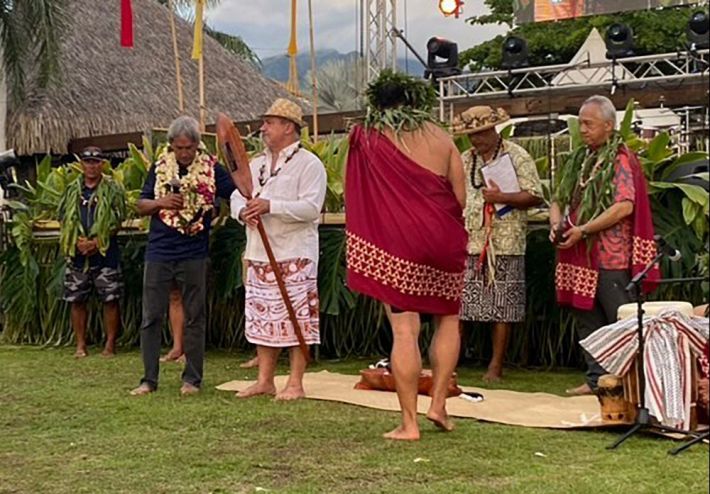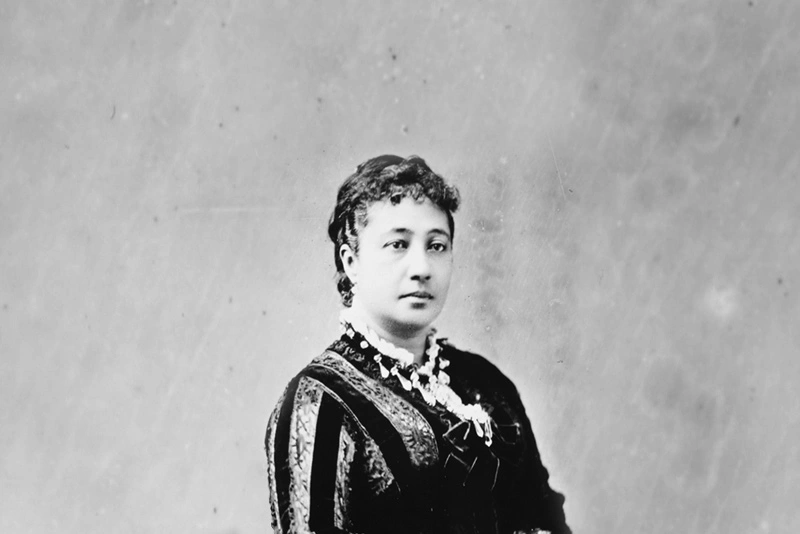In this Kūkahekahe, we learn about the ancestral connections illuminated during the recent Kealaikahiki Voyage of the Polynesian Voyaging Society’s canoes Hōkūleʻa and Hikianalia. Both waʻa successfully sailed from Hawaiʻi to Tahiti; it was the first long-distance voyage since 2019. Not only was this a training voyage for a new generation of navigators and crew, it also retraced one of the most well-known and well-travelled sea roads known as Kealaikahiki and returned to the sacred Marae Taputapuātea in Raʻiātea, French Polynesia.
What is Kealaikahiki?
Kahiki is a traditional reference to both a legendary place and the regional homeland of the Hawaiian people, which encompasses the Society Islands, Tuamotu Archipelago, and the Marquesas Islands of French Polynesia, and may also generally refer to closely-related island groups in the South Pacific.
Kealaikahiki (the path to Kahiki/Tahiti) is the Hawaiian name of the ancestral “sea road” between Hawaiʻi and Kahiki. Optimal times and conditions for sailing, as well as multiple access points allowed our ancestors to travel back and forth from Hawaiʻi and Kahiki for generations.
Kealaikahiki is marked in Hawaiʻi by the island of Kahoʻolawe and is the name of the channel on the northwest side of the island, as well as an ʻili, land division, and point on its southwestern tip. Waʻa from Hawaiʻi follow the pull of currents and winds on Kealaikahiki, consistently landing in a group of islands in French Polynesia known as the Tuamotu. In western Tuamotu, our modern navigators describe a pocket or cradle of atolls that include Rangiroa, Mataiva, and Tikehau that always seem to draw our canoes to shore for their initial landfall – this small island cluster is referred to as “pae Tuamotu.” In a 2019 symposium on Kealaikahiki, new-generation navigator Kaleomanuiwa Wong shared, “There’s something else that’s pulling us into those islands. It’s not just us navigating, but there’s kūpuna around us, other things guiding and pulling the canoe…It’s calling us, it’s bringing us there.”
Ancestral connections between Hawaiʻi and Kahiki are reflected in our mele, moʻolelo, ʻōlelo, and moʻokūʻauhau. Moʻikeha, Pele, Paʻao and Pili are chiefly voyagers whose epic journeys and legendary feats have been recounted for generations through story, song, and dance. Sailing northwest after departing Kahiki, navigator priest Kamahualele sees the southeastern coastline of Hawaiʻi Island and offers a compelling mele that is now a classic in Hawaiian literature, “Eia Hawaiʻi.” The opening lines proclaim:
Eia Hawaiʻi, he moku, he kanaka
Behold Hawaiʻi, an island, a man
He kanaka Hawaiʻi ē, he kanaka Hawaiʻi
Hawaiʻi is a man!
He kama na Kahiki
A child of Tahiti.
Ancestral place names conspicuously recur throughout Polynesia, serving as markers on an oceanic road map. Savaiʻi/Hawaiʻi/Hawaiki/Hawaiʻi and Fiji/Viti/Tahiti/Kahiki are a few examples. The royal families of Hawaiʻi and Tahiti share common ancestors originating from the Ulu/Nanaulu chiefly lines. In the nineteenth century, the Kamehameha and Pōmare Dynasties corresponded with each other expressing mutual support as Polynesian allies and royal counterparts. Today, that relationship continues through a cultural-educational partnership established in a declaration signed by Kamehameha Schools and heirs of the royal Pōmare family.
Ceremonies at Taputapuātea
Travel on Kealaikahiki between Hawaiʻi and Kahiki by our kūpuna enabled them to maintain their chiefly genealogical ties with our homeland, especially Ra‘iātea, the home of Marae Taputapuātea, one of the most sacred religious sites in Polynesia. Marae Taputapuātea is a complex of temple structures that was first constructed around 1000 A.D. One of the traditional names of Raʻiātea is Havaiʻi. It played a pivotal role in politics and chiefly governance throughout the region. Today, it is a UNESCO World Heritage Site. The marae was the piko of the Faʻatau Aroha, an ancient alliance of voyaging chiefs who pilgrimaged back along respective sea roads to Taputapuātea, a center of navigational knowledge. Stones from the marae were used to establish temples of the same name throughout Polynesia. According to tradition, Kapukapuākea is a heiau that lies in Waialua on Oʻahu’s northern shore and is thought to have a connection to the marae in Raʻiātea
The most recent Kealaikahiki Voyage included sacred ceremonies at Marae Taputapuātea, among them a renewal of the Faʻatau Aroha and granting of permission and blessing of the elders of marae for the upcoming Moananuiākea Voyage across the Pacific in 2023.
Learn more:
More information about these fascinating and culturally important topics can be found on the Waʻa Honua website.

Polynesian Voyaging Society President Nainoa Thompson and delegates from the French Polynesian government and Kamehameha Schools participate in the arrival ceremony for Hōkūleʻa and Hikianalia at Papeʻete, Tahiti, French Polynesia.

Map of Moananuiākea with Kealaikahiki. Map courtesy of the Center for Pacific Island Studies at University of Hawaiʻi at Mānoa. Additional text in yellow and red courtesy of Kaʻiwakīloumoku Pacific Indigenous Institute.

The Waʻa Honua website offers more information about Kealaikahiki and Marae Taputapuātea.

Marae Taputaptuātea in 2019.

Marae Taputaptuātea in 2019.
TAGS
hawaiian culture,kaʻiwakīloumoku,kealaikahiki voyage
CATEGORIES
Kaipuolono Article, Regions, Themes, Culture, Community, Hawaii Newsroom, KS Hawaii Home, Kapalama Newsroom, Kapalama Home, Maui Newsroom, KS Maui Home, Newsroom, Campus Programs, Hawaii, Kapalama, Maui, Department News, Ho‘okahua, Mālama Honua, Hawaii campus, Kapalama campus, Maui campus
Print with photos
Print text only










